Jason Kuen
Image Tokenizer Needs Post-Training
Sep 15, 2025Abstract:Recent image generative models typically capture the image distribution in a pre-constructed latent space, relying on a frozen image tokenizer. However, there exists a significant discrepancy between the reconstruction and generation distribution, where current tokenizers only prioritize the reconstruction task that happens before generative training without considering the generation errors during sampling. In this paper, we comprehensively analyze the reason for this discrepancy in a discrete latent space, and, from which, we propose a novel tokenizer training scheme including both main-training and post-training, focusing on improving latent space construction and decoding respectively. During the main training, a latent perturbation strategy is proposed to simulate sampling noises, \ie, the unexpected tokens generated in generative inference. Specifically, we propose a plug-and-play tokenizer training scheme, which significantly enhances the robustness of tokenizer, thus boosting the generation quality and convergence speed, and a novel tokenizer evaluation metric, \ie, pFID, which successfully correlates the tokenizer performance to generation quality. During post-training, we further optimize the tokenizer decoder regarding a well-trained generative model to mitigate the distribution difference between generated and reconstructed tokens. With a $\sim$400M generator, a discrete tokenizer trained with our proposed main training achieves a notable 1.60 gFID and further obtains 1.36 gFID with the additional post-training. Further experiments are conducted to broadly validate the effectiveness of our post-training strategy on off-the-shelf discrete and continuous tokenizers, coupled with autoregressive and diffusion-based generators.
Refer to Anything with Vision-Language Prompts
Jun 05, 2025Abstract:Recent image segmentation models have advanced to segment images into high-quality masks for visual entities, and yet they cannot provide comprehensive semantic understanding for complex queries based on both language and vision. This limitation reduces their effectiveness in applications that require user-friendly interactions driven by vision-language prompts. To bridge this gap, we introduce a novel task of omnimodal referring expression segmentation (ORES). In this task, a model produces a group of masks based on arbitrary prompts specified by text only or text plus reference visual entities. To address this new challenge, we propose a novel framework to "Refer to Any Segmentation Mask Group" (RAS), which augments segmentation models with complex multimodal interactions and comprehension via a mask-centric large multimodal model. For training and benchmarking ORES models, we create datasets MaskGroups-2M and MaskGroups-HQ to include diverse mask groups specified by text and reference entities. Through extensive evaluation, we demonstrate superior performance of RAS on our new ORES task, as well as classic referring expression segmentation (RES) and generalized referring expression segmentation (GRES) tasks. Project page: https://Ref2Any.github.io.
LaViDa: A Large Diffusion Language Model for Multimodal Understanding
May 22, 2025Abstract:Modern Vision-Language Models (VLMs) can solve a wide range of tasks requiring visual reasoning. In real-world scenarios, desirable properties for VLMs include fast inference and controllable generation (e.g., constraining outputs to adhere to a desired format). However, existing autoregressive (AR) VLMs like LLaVA struggle in these aspects. Discrete diffusion models (DMs) offer a promising alternative, enabling parallel decoding for faster inference and bidirectional context for controllable generation through text-infilling. While effective in language-only settings, DMs' potential for multimodal tasks is underexplored. We introduce LaViDa, a family of VLMs built on DMs. We build LaViDa by equipping DMs with a vision encoder and jointly fine-tune the combined parts for multimodal instruction following. To address challenges encountered, LaViDa incorporates novel techniques such as complementary masking for effective training, prefix KV cache for efficient inference, and timestep shifting for high-quality sampling. Experiments show that LaViDa achieves competitive or superior performance to AR VLMs on multi-modal benchmarks such as MMMU, while offering unique advantages of DMs, including flexible speed-quality tradeoff, controllability, and bidirectional reasoning. On COCO captioning, LaViDa surpasses Open-LLaVa-Next-8B by +4.1 CIDEr with 1.92x speedup. On bidirectional tasks, it achieves +59% improvement on Constrained Poem Completion. These results demonstrate LaViDa as a strong alternative to AR VLMs. Code and models will be released in the camera-ready version.
Robust Latent Matters: Boosting Image Generation with Sampling Error
Mar 11, 2025



Abstract:Recent image generation schemes typically capture image distribution in a pre-constructed latent space relying on a frozen image tokenizer. Though the performance of tokenizer plays an essential role to the successful generation, its current evaluation metrics (e.g. rFID) fail to precisely assess the tokenizer and correlate its performance to the generation quality (e.g. gFID). In this paper, we comprehensively analyze the reason for the discrepancy of reconstruction and generation qualities in a discrete latent space, and, from which, we propose a novel plug-and-play tokenizer training scheme to facilitate latent space construction. Specifically, a latent perturbation approach is proposed to simulate sampling noises, i.e., the unexpected tokens sampled, from the generative process. With the latent perturbation, we further propose (1) a novel tokenizer evaluation metric, i.e., pFID, which successfully correlates the tokenizer performance to generation quality and (2) a plug-and-play tokenizer training scheme, which significantly enhances the robustness of tokenizer thus boosting the generation quality and convergence speed. Extensive benchmarking are conducted with 11 advanced discrete image tokenizers with 2 autoregressive generation models to validate our approach. The tokenizer trained with our proposed latent perturbation achieve a notable 1.60 gFID with classifier-free guidance (CFG) and 3.45 gFID without CFG with a $\sim$400M generator. Code: https://github.com/lxa9867/ImageFolder.
LazyDiT: Lazy Learning for the Acceleration of Diffusion Transformers
Dec 17, 2024Abstract:Diffusion Transformers have emerged as the preeminent models for a wide array of generative tasks, demonstrating superior performance and efficacy across various applications. The promising results come at the cost of slow inference, as each denoising step requires running the whole transformer model with a large amount of parameters. In this paper, we show that performing the full computation of the model at each diffusion step is unnecessary, as some computations can be skipped by lazily reusing the results of previous steps. Furthermore, we show that the lower bound of similarity between outputs at consecutive steps is notably high, and this similarity can be linearly approximated using the inputs. To verify our demonstrations, we propose the \textbf{LazyDiT}, a lazy learning framework that efficiently leverages cached results from earlier steps to skip redundant computations. Specifically, we incorporate lazy learning layers into the model, effectively trained to maximize laziness, enabling dynamic skipping of redundant computations. Experimental results show that LazyDiT outperforms the DDIM sampler across multiple diffusion transformer models at various resolutions. Furthermore, we implement our method on mobile devices, achieving better performance than DDIM with similar latency.
XQ-GAN: An Open-source Image Tokenization Framework for Autoregressive Generation
Dec 02, 2024



Abstract:Image tokenizers play a critical role in shaping the performance of subsequent generative models. Since the introduction of VQ-GAN, discrete image tokenization has undergone remarkable advancements. Improvements in architecture, quantization techniques, and training recipes have significantly enhanced both image reconstruction and the downstream generation quality. In this paper, we present XQ-GAN, an image tokenization framework designed for both image reconstruction and generation tasks. Our framework integrates state-of-the-art quantization techniques, including vector quantization (VQ), residual quantization (RQ), multi-scale residual quantization (MSVQ), product quantization (PQ), lookup-free quantization (LFQ), and binary spherical quantization (BSQ), within a highly flexible and customizable training environment. On the standard ImageNet 256x256 benchmark, our released model achieves an rFID of 0.64, significantly surpassing MAGVIT-v2 (0.9 rFID) and VAR (0.9 rFID). Furthermore, we demonstrate that using XQ-GAN as a tokenizer improves gFID metrics alongside rFID. For instance, with the same VAR architecture, XQ-GAN+VAR achieves a gFID of 2.6, outperforming VAR's 3.3 gFID by a notable margin. To support further research, we provide pre-trained weights of different image tokenizers for the community to directly train the subsequent generative models on it or fine-tune for specialized tasks.
ImageFolder: Autoregressive Image Generation with Folded Tokens
Oct 02, 2024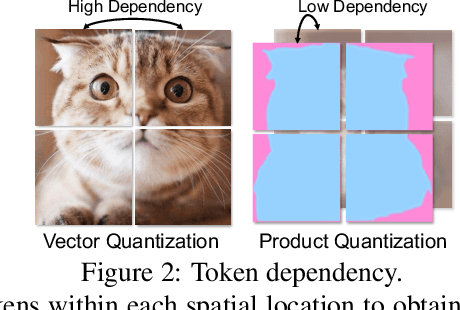
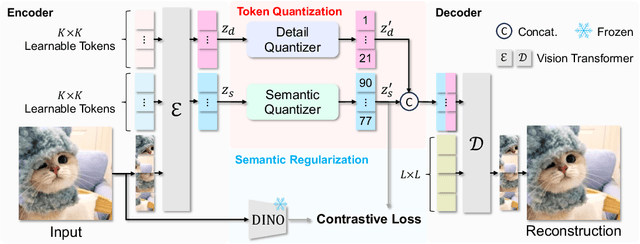

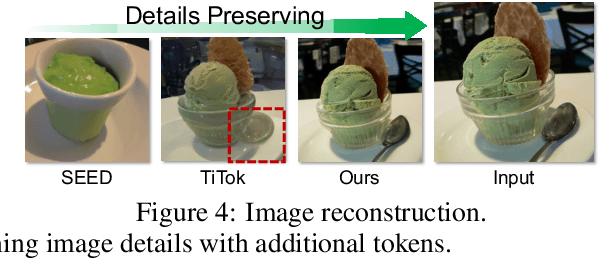
Abstract:Image tokenizers are crucial for visual generative models, e.g., diffusion models (DMs) and autoregressive (AR) models, as they construct the latent representation for modeling. Increasing token length is a common approach to improve the image reconstruction quality. However, tokenizers with longer token lengths are not guaranteed to achieve better generation quality. There exists a trade-off between reconstruction and generation quality regarding token length. In this paper, we investigate the impact of token length on both image reconstruction and generation and provide a flexible solution to the tradeoff. We propose ImageFolder, a semantic tokenizer that provides spatially aligned image tokens that can be folded during autoregressive modeling to improve both generation efficiency and quality. To enhance the representative capability without increasing token length, we leverage dual-branch product quantization to capture different contexts of images. Specifically, semantic regularization is introduced in one branch to encourage compacted semantic information while another branch is designed to capture the remaining pixel-level details. Extensive experiments demonstrate the superior quality of image generation and shorter token length with ImageFolder tokenizer.
ControlVAR: Exploring Controllable Visual Autoregressive Modeling
Jun 14, 2024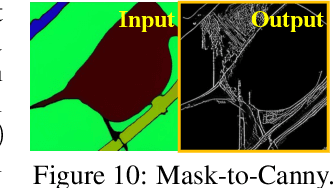

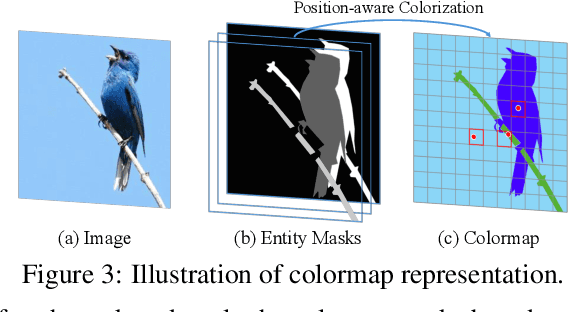
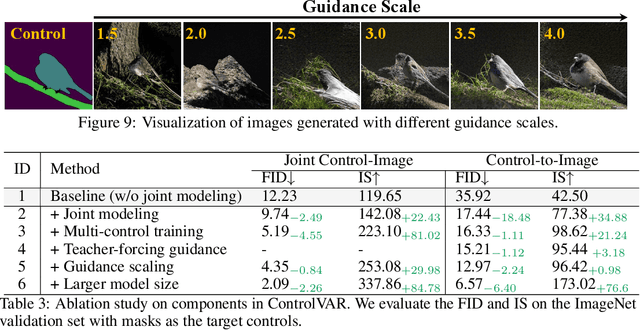
Abstract:Conditional visual generation has witnessed remarkable progress with the advent of diffusion models (DMs), especially in tasks like control-to-image generation. However, challenges such as expensive computational cost, high inference latency, and difficulties of integration with large language models (LLMs) have necessitated exploring alternatives to DMs. This paper introduces ControlVAR, a novel framework that explores pixel-level controls in visual autoregressive (VAR) modeling for flexible and efficient conditional generation. In contrast to traditional conditional models that learn the conditional distribution, ControlVAR jointly models the distribution of image and pixel-level conditions during training and imposes conditional controls during testing. To enhance the joint modeling, we adopt the next-scale AR prediction paradigm and unify control and image representations. A teacher-forcing guidance strategy is proposed to further facilitate controllable generation with joint modeling. Extensive experiments demonstrate the superior efficacy and flexibility of ControlVAR across various conditional generation tasks against popular conditional DMs, \eg, ControlNet and T2I-Adaptor.
SOHES: Self-supervised Open-world Hierarchical Entity Segmentation
Apr 18, 2024Abstract:Open-world entity segmentation, as an emerging computer vision task, aims at segmenting entities in images without being restricted by pre-defined classes, offering impressive generalization capabilities on unseen images and concepts. Despite its promise, existing entity segmentation methods like Segment Anything Model (SAM) rely heavily on costly expert annotators. This work presents Self-supervised Open-world Hierarchical Entity Segmentation (SOHES), a novel approach that eliminates the need for human annotations. SOHES operates in three phases: self-exploration, self-instruction, and self-correction. Given a pre-trained self-supervised representation, we produce abundant high-quality pseudo-labels through visual feature clustering. Then, we train a segmentation model on the pseudo-labels, and rectify the noises in pseudo-labels via a teacher-student mutual-learning procedure. Beyond segmenting entities, SOHES also captures their constituent parts, providing a hierarchical understanding of visual entities. Using raw images as the sole training data, our method achieves unprecedented performance in self-supervised open-world segmentation, marking a significant milestone towards high-quality open-world entity segmentation in the absence of human-annotated masks. Project page: https://SOHES.github.io.
SegGen: Supercharging Segmentation Models with Text2Mask and Mask2Img Synthesis
Nov 06, 2023Abstract:We propose SegGen, a highly-effective training data generation method for image segmentation, which pushes the performance limits of state-of-the-art segmentation models to a significant extent. SegGen designs and integrates two data generation strategies: MaskSyn and ImgSyn. (i) MaskSyn synthesizes new mask-image pairs via our proposed text-to-mask generation model and mask-to-image generation model, greatly improving the diversity in segmentation masks for model supervision; (ii) ImgSyn synthesizes new images based on existing masks using the mask-to-image generation model, strongly improving image diversity for model inputs. On the highly competitive ADE20K and COCO benchmarks, our data generation method markedly improves the performance of state-of-the-art segmentation models in semantic segmentation, panoptic segmentation, and instance segmentation. Notably, in terms of the ADE20K mIoU, Mask2Former R50 is largely boosted from 47.2 to 49.9 (+2.7); Mask2Former Swin-L is also significantly increased from 56.1 to 57.4 (+1.3). These promising results strongly suggest the effectiveness of our SegGen even when abundant human-annotated training data is utilized. Moreover, training with our synthetic data makes the segmentation models more robust towards unseen domains. Project website: https://seggenerator.github.io
 Add to Chrome
Add to Chrome Add to Firefox
Add to Firefox Add to Edge
Add to Edge